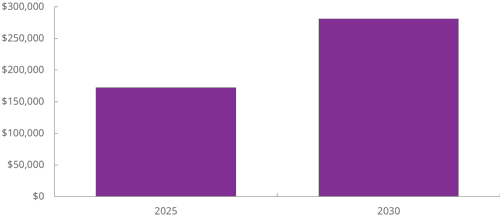Navigating the Smart Traffic Boom: 5 Ways Vendors Can Drive ROI & Adoption
Last week was an exemplary week for the smart traffic management market, with the UK government announcing a transport AI action plan that aims to deliver smarter, safer and greener journeys. The 23-point action plan aims to integrate AI across the UK’s transport systems, to optimise traffic flows, infrastructure management and public transport systems, as well as accelerate decarbonisation goals in the transportation sector.
In addition to this, Milestone Systems, a video technology software company announced that its Project Hafnia would be coming to Europe, beginning with the city of Genova. The project aims to provide developers with high-quality video data to accurately train visual AI models. Project Hafnia is in partnership with NVIDIA, and leverages NVIDIA’s NeMo Curator platform which is designed to enhance AI training. In Italy, the project will be used to enhance traffic management systems using video data trained on the NVIDIA platform.
These two projects highlight the acceleration of smart traffic adoption, which has previously been slowed by budget constraints, especially when transportation departments and agencies have to upgrade or update legacy systems.
A key driver of the accelerated adoption of smart traffic management solutions is the cost saving that can result from reducing emissions and congestion; which our latest research anticipates will reach $281 billion by 2030.
Total Congestion & Emissions Cost Savings by Smart Traffic Management Systems ($m)

Source: Juniper Research
Driven by the substantial cost savings smart traffic management systems can deliver, Juniper Research predicts the market will surge to $32.7 billion by 2030; a 121% increase from $14.8 billion in 2025.
To take full advantage of this rapid growth over the next five years, smart traffic management providers should focus on the following strategic priorities:
Strategy #1: Development of Hybrid Solutions
With the proliferation of cloud computing, Juniper Research expects hybrid deployments, which combine on-premises deployments with a cloud and edge computing element, to be the most popular deployment model.
This deployment model strikes a balance between the flexibility, scalability and real-time response of cloud and edge computing, and the security and control of on-premises deployments. In addition, it allows vendors to ensure predictable recurring income through the use of subscription-based business models for services such as device equipment maintenance or traffic analytics; thereby maximising revenue.
Strategy #2: Highlight Return on Investment (ROI)
Given that budget constraints have previously slowed growth in the market, smart traffic management vendors must ensure they collect data on how effective their products and solutions are at providing a fast ROI, as well as for reducing carbon emissions. As the market becomes more competitive this will become a key marketing tool for vendors.
In addition, smart traffic management vendors must offer flexible payment services, as this will be a key factor in transportation departments choosing them over other competitors. Vendors can do this by offering monthly repayments to spread the purchase cost, or by adopting modular solutions which allow clients to upgrade over time. This will lower the barrier to entry, enabling more transportation departments to adopt smart traffic management solutions.
Strategy #3: Data Monetisation
In the era of Big Data, smart traffic management vendors have a unique opportunity to tap into a new revenue stream: data monetisation. The data they collect on traffic flows is useful to a number of industries, including insurance, marketing, tourism, retail and telecommunications.
To take full advantage of this opportunity, vendors must ensure that they offer access to both raw data and key analytic insights on a tiered subscription model, with raw data being offered in lower tiers and the premium tiers including access to more insights and analytics. Vendors must ensure they have the right permissions to monetise data before they offer these services; ensuring the use of data with customers in their contracts.
Strategy 4: Adopt an Interoperability-first Approach
As legacy systems are still widely used, smart traffic management vendors must ensure they create solutions that are highly interoperable. They can do this by developing and supporting open APIs and plug-and-play solutions.
Vendors should also incorporate middleware into their solutions, to enable clients with legacy software to enhance their systems without completely replacing them. To do this, smart traffic management vendors must ensure they adopt a modular system architecture, enabling clients to enhance their systems without overhauling them.
Strategy 5: Implement Robust Data Privacy
Data privacy remains a key concern in gaining public acceptance of smart traffic management solutions. Smart traffic management vendors must tackle this issue by using privacy-enhancing technology (PETs), which are methods of minimising personal data collection. These methods range from using AI to generate synthetic datasets that mimic real datasets, to using data anonymisation techniques that remove personal data.
In addition to implementing enhanced data privacy techniques, smart traffic management vendors must also adopt a secure-by-design approach to developing their traffic monitoring products, as well as incorporating robust security into their products. Juniper Research anticipates that cyber security threats will continue to increase, and thus adopting these solutions will be key to ensuring data privacy and integrity, as well as gaining public acceptance and trust.
Michelle is a Research Analyst in Juniper Research’s IoT & Emerging Technology team, where she explores some of the most dynamic and fast-moving areas of tech. She delivers insight and analysis on rapidly evolving markets, such as Smart Traffic Management, Private Cellular Networks, and Quantum Technology.
Latest research, whitepapers & press releases
-
 ReportDecember 2025
ReportDecember 2025AI Agents for Customer Experience Platforms Market: 2025-2030
Our comprehensive AI Agents for Customer Experience Platforms research suite comprises detailed assessment of a market that is set to disrupt mobile communications. It provides stakeholders with insight into the key opportunities within the AI agents for customer experience platforms market over the next two years.
VIEW -
 ReportDecember 2025Fintech & Payments
ReportDecember 2025Fintech & PaymentseCommerce Fraud Prevention Market: 2025-2030
Our eCommerce Fraud Prevention research suite provides a detailed and insightful analysis of this evolving market; enabling stakeholders from financial institutions, law enforcement agencies, regulatory bodies and technology vendors to understand future growth, key trends, and the competitive environment.
VIEW -
 ReportNovember 2025Telecoms & Connectivity
ReportNovember 2025Telecoms & ConnectivityeSIMs & iSIMs Market: 2025-2030
Juniper Research’s eSIMs and iSIMs research suite offers insightful analysis of a market set to experience significant growth in the next five years. The research suite provides mobile network operators (MNOs), original equipment manufacturers (OEMs), and eSIM management and platforms vendors with intelligence on how to capitalise on the market growth, and guidance on how eSIM-only devices and sensors, SGP.42, in-factory provisioning, and iSIMs will change the competitive landscape.
VIEW -
 ReportNovember 2025Fintech & Payments
ReportNovember 2025Fintech & PaymentsModern Card Issuing Platforms Market: 2025-2030
Our Modern Card Issuing Platforms Market research suite provides a detailed and insightful analysis of this evolving market; enabling stakeholders from banks, financial institutions, fintech companies, and technology vendors to understand future growth, key trends, and the competitive environment.
VIEW -
 ReportNovember 2025Fintech & Payments
ReportNovember 2025Fintech & PaymentsDigital Wallets Market: 2025-2030
Our digital wallets research suite provides detailed analysis of this rapidly changing market; allowing digital wallet providers to gain an understanding of key payment trends and challenges, potential growth opportunities, and the competitive environment.
VIEW -
 ReportOctober 2025Fintech & Payments
ReportOctober 2025Fintech & PaymentsDigital Identity Market: 2025-2030
Juniper Research’s Digital Identity research suite provides a comprehensive and insightful analysis of this market; enabling stakeholders, including digital identity platform providers, digital identity verification providers, government agencies, banks, and many others, to understand future growth, key trends, and the competitive environment.
VIEW
-
 WhitepaperDecember 2025Telecoms & Connectivity
WhitepaperDecember 2025Telecoms & ConnectivityHuman + AI: Drivers of Customer Experience AI Agents in 2026
Our complimentary whitepaper, Human + AI: Drivers of Customer Experience AI Agents in 2026, examines the key drivers of the AI agents for customer experience platforms market in 2025.
VIEW -
 WhitepaperDecember 2025Fintech & Payments
WhitepaperDecember 2025Fintech & PaymentsBeyond Chargebacks: The True Cost of Fraud for Digital Commerce
Our complimentary whitepaper, Beyond Chargebacks: The True Cost of Fraud for Digital Commerce, examines the state of the eCommerce fraud prevention market; considering the impact of evolving digital fraud strategies, including key trends such as identity theft, account takeovers, chargebacks, policy abuse and friendly fraud.
VIEW -
 WhitepaperNovember 2025Telecoms & Connectivity
WhitepaperNovember 2025Telecoms & ConnectivityeSIM-only Devices: The Impact on Operators, Consumers, and IoT
Our complimentary whitepaper, eSIM-only Devices: The Impact on Operators, Consumers, and IoT, explores the challenges and opportunities for the three segments, with a particular focus on eSIM-only smartphones and SGP.42.
VIEW -
 WhitepaperNovember 2025Fintech & Payments
WhitepaperNovember 2025Fintech & PaymentsUnlocking the Next Stage of Growth for Modern Card Issuing Platforms
This free whitepaper analyses key trends shaping the modern card issuing space, and the ways in which modern card issuing platforms can capture growth.
VIEW -
 WhitepaperNovember 2025Fintech & Payments
WhitepaperNovember 2025Fintech & PaymentsTop 10 Fintech & Payments Trends 2026
Fintech is evolving fast. From stablecoins to agentic AI, our annual guide reveals the shifts redefining payments, digital identity, and the future of money in 2026. Download your copy today.
VIEW -
 WhitepaperNovember 2025Fintech & Payments
WhitepaperNovember 2025Fintech & PaymentsDigital Wallets: Empowering Financial Inclusivity
Our complimentary whitepaper, Digital Wallets: Empowering Financial Inclusivity, examines the state of the digital wallets market; considering the impact of digital wallets on different geographies, how they are shaping the modern payments landscape through lower transaction fees and promoting financial inclusivity for underbanked populations, and how they are competing with established payment methods.
VIEW
-
IoT & Emerging Technology
Juniper Research Unveils Top 10 Emerging Tech Trends to Watch in 2026
January 2026 -
Fintech & Payments
Digital Identity App Usage to Hit 6.2 Billion by 2030, Driven by Shift to Decentralised Models
December 2025 -
Telecoms & Connectivity
Travel eSIM Margins Under Pressure as Revenue per Gigabyte Falls 10% Globally in Two Years
December 2025 -
Telecoms & Connectivity
AI Agents to Power 1,000% More Customer Interactions for Enterprises Globally by 2027
December 2025 -
IoT & Emerging Technology
Global D2C Revenue Set for $370 Million Surge, But Satellite Operators Should Not Chase Full MNO Status
December 2025 -
Fintech & Payments
Digital Goods Fraud to Cost eCommerce Merchants $27 Billion Globally by 2030 as AI Tools Accelerate Attacks
December 2025





















